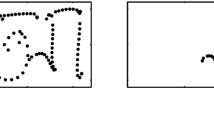Abstract:
This paper presents a new structural method for the recognition of handwritten numerals. Contour shape features, such as convex arcs, concave arcs, line segments, end-point arcs and holes from the contours of numeric characters, are used to describe numeral characters. A new method of measuring the similarity between a sample and class is proposed. A two-stage recognition methodology is also presented, in which two rejection criteria are introduced. In the first stage of recognition, an input sample is given an identity or categorised as either first class or second class rejection, based on similarity measures between the input sample and each of the ten numeral classes. In the second stage of recognition, strategies are introduced to modify the structural description of the input sample if it is in first class rejection and a classifier focused on pairwise discrimination is applied if the input sample is in second class rejection. Experimental results indicate that the overall performance of the proposed method compares favourably with those achieved by other methods found in the literature.
Similar content being viewed by others
Author information
Authors and Affiliations
Additional information
Received: 10 July 1998¶Received in revised form: 15 December 1998¶Accepted: 15 January 1999
Rights and permissions
About this article
Cite this article
Lou, Z., Liu, K., Yang, J. et al. Rejection Criteria and Pairwise Discrimination of Handwritten Numerals Based on Structural Features. Pattern Analysis & Applications 2, 228–238 (1999). https://doi.org/10.1007/s100440050031
Issue Date:
DOI: https://doi.org/10.1007/s100440050031




